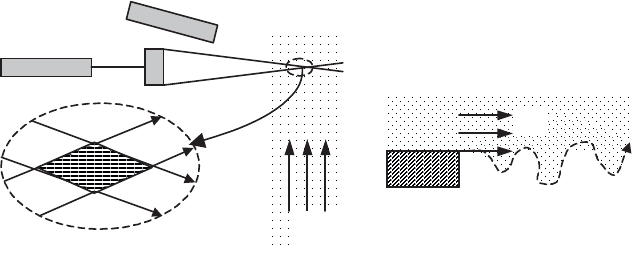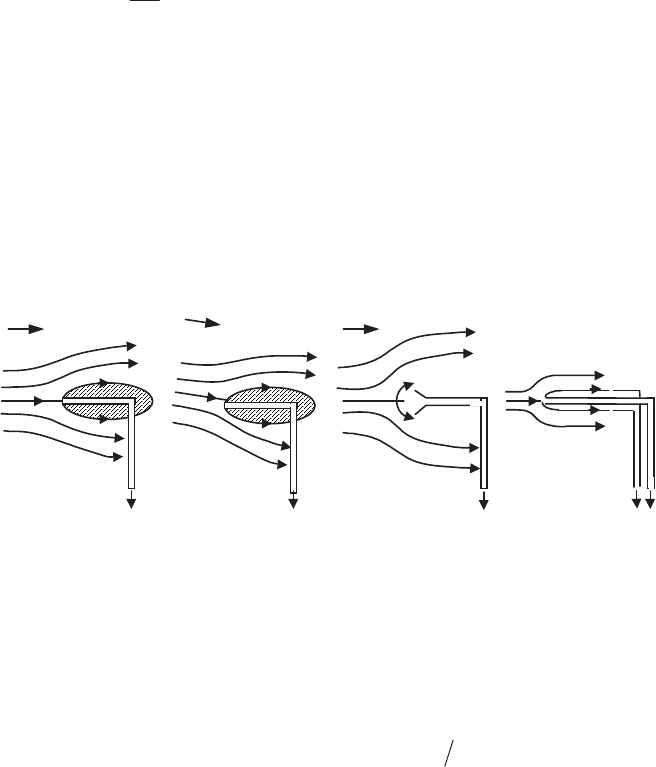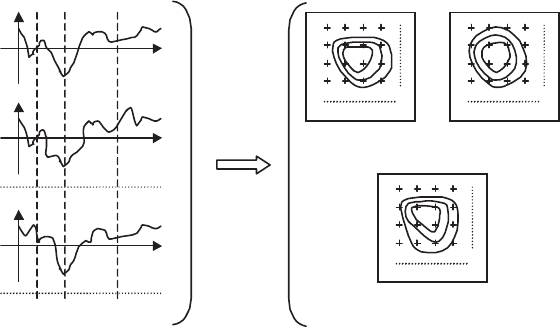Peube J-L. Fundamentals of fluid mechanics and transport phenomena
Подождите немного. Документ загружается.


Measurement, Representation and Analysis of Temporal Signals 343
7.2.3.2. Lagrangian anemometry
In general we want to know the velocity at an observation point which we define
with respect to the laboratory reference frame (Euler variables). Fluid particles are
not individually visible and it is necessary in all cases to introduce solid elements,
which are entrained by the fluid. The problem of solid particle entrainment by a
fluid is therefore essential.
In the case of cup anemometers (Figure 7.2a), we use the dissymmetry of a
rotating device, which presents a resistance to the fluid movement in a given
direction (cup C
1
) and very low resistance in the other direction (cup C
2
). The result
is that the cup situated at position C
1
tends to follow the flow, whereas the other, C
2
induces a very low torque on the moveable system. Alternatively a propeller can be
used (Figure 7.2b). As the elements of these devices are not entrained by the fluid
with the fluid velocity, it is necessary to calibrate them.
V
C
2
C
1
V
(a) (b)
Figure 7.2. (a) Cup anemometer or (b) propeller anemometer
Laser Doppler Anemometry (LDA) involves the creation of a system of
interference fringes by means of a laser whose beam is split into two beams focused
by a lens (Figure 7.3a). Very tiny particles crossing the fringes are alternatively
illuminated as they cross the fringes. It is possible to measure the scattered light by
means of a photomultiplier. The frequency value n of the light signal measured
allows a calculation of the particle velocity, equal to i.n, where i is the inter-fringe
spacing, easily obtained from the optical characteristics of the device. The
denomination Doppler comes from the fact that the procedure can also be explained
by considering the variation of the optical frequency which occurs when the particle
scatters the light provided by each of the coherent light beams.

344 Fundamentals of Fluid Mechanics and Transport Phenomena
V
V
f
(a) (b)
P
L S
Z
Figure 7.3.
(a) Principle of anemometric measurement by ALD (L, laser; S, beam-splitter and
focusing lens; Z, fringes in the measurement zone; P, photodetector centered on the zone Z);
(b) bias in ALD measurement in a non-homogenous flow seeding
The principle of anemometric measurement assumes the presence of small
particles, which are in suspension in the fluid [DUR 81]. These nearly always exist
in water, but it is necessary to “seed” gaseous flows by means of droplets obtained
by the pulverization of some suitable oil, or by very light smoke obtained by
combustion of some suitable substance (incense for example) so as to obtain
particles whose dimensions are in the order of 1 Pm The introduction of particles
needs to be effected so as to produce as uniform a distribution as possible in the
flow. Figure 7.3b shows a region of flow between a stream of velocity V and a
region of flow at rest; the frontier f between the two oscillates unpredictably; only
fluid particles coming from the flow containing seeding will provide a measurement
signal: we thus see a systematic bias in the measurement of the velocity which will
“favor” the same kinds of flow structures.
The LDA procedure provides a local and instantaneous measurement in most
conditions. It is well suited to the laboratory study of small flow structures and it
even allows us to obtain acoustic velocities (from 1 mm/s to 1 cm/s) [PEU 92]. Cup
anemometers only allow measurement in a volume in the order of some
considerable fraction of a dm
3
, and therefore these are only suitable for quite global
measurements (wind velocity in meteorology or air-conditioning units).
Let us finally recall anemometric measurements at the atmospheric scale, which
are obtained by releasing balloons that move at constant altitude and whose position
can be tracked by satellite. This method provides trajectories (Lagrangian
viewpoint) and not streamlines (Eulerian representation of meteorological charts).

Measurement, Representation and Analysis of Temporal Signals 345
7.2.3.3. Eulerian anemometry
We here use a device, which is fixed in space, on which the flow acts by creating
a phenomenon whose intensity (overpressure, temperature, etc.) depends on the
velocity of the flow.
In the steady flow of an ideal incompressible fluid for which Bernoulli’s theorem
is valid, the difference in driving pressure between two points whose velocities are
respectively equal to V and 0 is equal to:
2
2
V
p
g
U
'
The measurement of velocity is thus realized by means of a measurement of a
pressure difference. A zero velocity is obtained when a flow is stopped by an
obstacle, on the upstream edge of which a stagnation point A occurs (Figure 7.4a); it
suffices to measure the total driving pressure (or the total pressure for a gas) at this
point A by connecting the orifice to a pressure probe. This orifice needs to be of
very small size in order to obtain a well-defined pressure value. However, if the
flow is not correctly aligned with respect to the obstacle, the orifice will not be at
the stagnation point and will not therefore measure the total pressure (Figure 7.4b).
The effect of the angle of incidence can be reduced by using a tube with a divergent
opening (Prandtl tube, Figure 7.4c).
A
A
VV
A
V
(a) (b)
(c)
Prandtl tube
A
L
L
(d)
Pitot tube
p
g
+
U
V
2
/2
U
V
2
/2
p
g
+
U
V
2
/2
z
p
g
+
U
V
2
/2
Figure 7.4.
Measurement of stagnation pressure in a flow
By placing the total pressure tube inside a streamlined cylindrical tube (Figure
2.4d), the flow quickly returns to a uniform state (after 5 or 6 external diameters);
lateral orifices L placed on the external wall will measure the static driving pressure
p
g
(or static pressure in a gas) and the difference in pressure between the two tubes
provides a direct estimate of the dynamic pressure
2
2
VU . This device, known as a
346 Fundamentals of Fluid Mechanics and Transport Phenomena
Pitot tube, constitutes a somewhat cumbersome obstacle (it is at least a few
centimeters in length); it assumes that the flow velocity is defined and uniform at
this scale.
Bernoulli’s theorem is also applicable for a compressible fluid in subsonic flow,
provided of course that the compressible form of Bernoulli’s equation is used. The
problem is more difficult in supersonic flows because of the existence of a shock
wave upstream of the tube, across which specific laws need to be applied.
Hot wire anemometry is based on a very different principle: the thermal power
evacuated by a heated body is an increasing function of velocity. If the body is
electrically heated, this power can be known by means of a measurement of
intensity. It can be used in a flow in which velocity fluctuations exist with very
small hotwire diameters (1 to 5 Pm) whose thermal inertia is compensated by a
suitable supply (constant temperature anemometer). It is thus possible to measure
velocity fluctuations whose frequencies may be as large as 1,000 to 2,000 Hz. With
two or three differently inclined hotwires it is possible to measure the instantaneous
velocity vector. We therefore have in the hotwire anemometer a powerful means of
knowing the velocity fluctuations provided these remain smaller than the mean
velocity, as it is clearly not possible to distinguish the velocity direction from a
thermal power measurement alone.
7.2.4. Temperature measurements
The local measurement of temperature at the heart of a continuous medium can
be achieved by optical methods (measurements at a distance) or by means of probes
introduced into the flow. Optical procedures are based on emission phenomena,
which are associated with absorption phenomena, the medium considered being thus
semi-transparent for the wavelengths used. This leads to calculation methods which
are often complex and we direct the reader to specialized texts for more detail (see
for example ([BRU 95], [JOH 98], [MAR 99], [MCG 88]).
In a manner analogous to the introduction of pressure or velocity measurement
probes, the introduction of temperature measurement probes provokes a
modification of the flow and associated thermal phenomena only of importance at
high velocities. As with the pressure, the temperature of a fluid will depend on the
position of the measurement element on the wall of the probe; these measurements
are generally performed either at a stagnation point, or on a wall which is parallel to
the flow. For an ideal gas in adiabatic flow, we have conservation of total enthalpy
(section 4.3.2.3.2), or, with T
a
the stagnation temperature:

Measurement, Representation and Analysis of Temporal Signals 347
app
TC
V
TC
2
2
However, the measurement of temperature presents additional problems, as the
temperature of the sensible part of the probe is the result of a thermal balance
between the heat flux transmitted by the flow, the heat flux in the metallic electric
wires and in the support structure, and the thermal radiation caused by the
surrounding walls. As the last two quantities are independent of the flow, their
influence is less important on the temperature measurements at higher velocities.
We will note that for high enough velocities, thermal dissipation in the vicinity of
the obstacle, which is constituted by the temperature probe, may be a non-negligible
factor ([SCH 99]). Temperature measurements in flows are always difficult and
should not be attempted without a careful discussion of the different thermal
phenomena which may be present.
7.2.5. Measurements of concentration
The measurement of the concentration of a mixture is quite difficult. Very often
a fluid sample is taken via local suction by a tubular probe. The probe geometry is
not important here, but the suction velocity needs to be suitably chosen so as not to
alter the fluid trajectories in the extraction zone (isokinetic sampling) ([BRU 95],
[JOH 98], [CHE 88], [LIP 05]). An analysis of the fluid sample is then performed
using physico-chemical methods adapted to the mixture under study.
In certain cases, it is possible to perform measurements from a distance by
means of optical procedures associated with radiation emission. It is also possible to
use physico-chemical reactions on a surface placed in the flow, but the specific
procedure employed is always dependent on the particular mixture studied, and
often requires modeling of the heat and mass transfer phenomena involved. For
example, we have already said that evaporation phenomena induce a variation of
temperature: a wet thermometer does not measure temperature of air (section 2.3.2).
In a conducting liquid medium, the use of electrodes allows the measurement of
concentration in certain circumstances (diffusion phenomena have to be negligible).
7.2.6. Fields of quantities and global measurements
7.2.6.1.
Introduction to field quantities
In practice, local quantities are of limited interest, unless they are representative
of the device being studied. The dimensioning of a device or the control of its
operation requires knowledge of global quantities (mass flux, thermal power, etc.)
348 Fundamentals of Fluid Mechanics and Transport Phenomena
or of certain local quantities, which may be associated with possible damage
(temperature at a hot spot in thermal systems). These two kinds of data require
knowledge of the associated field quantities, either for integration (computation of a
flow rate for example) or for identifying the point where critical values may be
attained. In many situations, knowledge of field quantities can only be obtained by
exploring the domain by means of local measurement probes. This is clearly only of
interest if the concerned experiment is reproducible, which can only be the case if
the flow is perfectly defined. It is then possible to obtain velocity, pressure,
temperature fields, etc. This situation does not include poorly defined flows
regardless of their origin (instabilities, turbulence, etc.).
Steady flows do not present particular difficulties, since the instant of
measurement is unimportant. For unsteady flows, this is not the case however, as the
fields of a quantity g(x
i,
t) now depend on time. The installation of an ensemble of
probes, which instantaneously and simultaneously measure the quantity g over the
entire domain considered, is not generally realistic. Only methods which allow the
obtaining of full instantaneous fields by optical means are possible; such techniques
have seen significant progress in recent years.
7.2.6.2.
Direct obtaining of field quantities of a flow
7.2.6.2.1.
Visualizations
The visualization of a flow can consist of “photographing” visible material
elements which have been placed into the flow without disturbing it at fixed
locations with respect to the observer. For instance, it is possible to place pieces of
light wires on a grid inside a flow; these will then be oriented depending on the
direction of the local velocity. The same procedure can be used on a wall in order to
obtain the direction of streamlines and to visualize separated zones. The visible
effect is here a Eulerian representation (observation of streamlines).
It is also possible to introduce streams of smoke into the air or to inject colored
dyes in a liquid medium. This kind of injection requires certain precautions (suitable
injection velocity, density of colored dye equal to that of the liquid medium, etc.).
Diverse particles can also be introduced and entrained by the flow (which has not at
some point stopped to observe the flow structures visible in a river, a gutter, etc.).
However, it is important to remember that this kind of visualization is Lagrangian,
and it shows streaklines which may be very different from the streamlines and
trajectories (section 3.3.2).
Finally, Eulerian visualizations can be performed on walls by means of physical
processes (entrainment of a coating comprising particles for example) or physico-
chemical processes producing a differential deposit on wall streamlines (evaporation
Measurement, Representation and Analysis of Temporal Signals 349
of the coating solvent, or electrochemical deposit under particular conditions). For a
more complete and practical information, see ([HAN 05], [MER 87], [YAN 01]).
7.2.6.2.2. Obtaining instantaneous fields
The preceding visualization methods are rather qualitative. We can make these
quantitative by introducing tracer particles and photographing these with suitable
lighting, either over a period short enough for visualization of the distance covered
during the lighting-time or by means of two successive light pulses. It then remains
to measure the segment covered by each particle in order to ascertain the velocity. It
is obviously necessary to know the position of the particles in space, and this is done
by generating a light sheet of small thickness, particles external to this light sheet
not being visible. This method requires a seeding of particles with very small
diameter (1 to 3 Pm) which is not biased (section 7.2.3.2). Such approaches are
known as particle image velocimetry (PIV). Modern techniques for the generation
of two close light pulses of short duration (5 to 10 ns) by a suitable laser and the
processing of images have made this technique less fastidious than in the past ([RAF
98], [STA 00], [STA 00]). However, in turbulent flows, the obtaining of a mean
velocity field requires statistics to be gathered from a large number of identical
experiments (sections 7.2.6.3.2 and 7.2.6.3.3).
Optical methods of temperature and concentration measurement provide field
quantities; as mentioned earlier, the semi-transparent aspect of the medium
considered (which is both emissive and absorbent) leads to rather global
measurements which depend on thickness, and a deconvolution of signals acquired
in a band of wavelengths is necessary in order to reconstruct the value of the
quantity in each slice. These optical procedures are used in observations by
meteorological satellites.
7.2.6.3.
Application in unsteady flows
7.2.6.3.1.
Unsteady repeatable flows
We here assume that the flow can be reproduced at will, in other words there
exists an initial instant with identical initial and boundary conditions. This is true for
transitional regimes, which precede the established regimes, and also that of
periodic flows.
We repeat the flow regime which is to be studied as many times as necessary,
and measure the value of the quantity g(x, t) each time (Figure 7.5a) at different
points (x
1
,
x
2
,…, x
p
,…). We then represent the fields (Figure 7.5b) at successive
instants (tx
1
,
t
2
,…, t
n
,…) which we have chosen. These operations, which are in
principle quite simple, clearly require the use of numerical calculations ([PEU 79],
[PEU 89], [PEU 91]).

350 Fundamentals of Fluid Mechanics and Transport Phenomena
t
g
(
x
1
, t )
g
(
x
2
, t )
g
(
x
p
,t)
t
t
t
1
t
2
t
n
g
(
x
i
,
t
1
)
g
(
x
i
, t
2
)
g
(
x
i
, t
n
)
(a) time representation of g(x,t) (b) space representation of g(x,t)
Figure 7.5. Obtaining instantaneous fields of quantity g from
point measurements as a function of time
7.2.6.3.2. “Steady” turbulence flows
A turbulent flow presents random fluctuations. We will here call a “steady”
turbulent flow any flow whose mean value of the measured quantity, over a large
enough time, does not depend on the initial instant chosen to begin the
measurement. We see immediately that an analogous procedure to that described in
the last section allows the obtention of quantities derived from the curves g(x, t) by
means of appropriate operations (mean values, fluctuations, variance of the quantity
g, etc.) used in the study of turbulent flows ([SCH 99], [YIH 77]).
7.2.6.3.3. Unsteady “reproducible” turbulent flows
This category of flow is obtained by imposing fixed initial and boundary
conditions that are defined functions of time. As before, we repeat successive
measurements at different points by reproducing the experiment exactly. As the
flow is maintained in a turbulent state, in other words it fluctuates from one
experiment to the next, it is necessary to perform the measurement a sufficient
number of times at each point, for the associated statistical quantities to be
calculated; these statistical quantities are the only ones which are meaningful for this
ensemble of experiments.
Measurement, Representation and Analysis of Temporal Signals 351
7.2.6.4.
Measurement of global quantities
Global quantities such as mass or volume flux, internal energy or enthalpy flux
are very important in industry. Precise knowledge of these can be obtained by
integrating local measurements performed on a grid that covers the region of
interest. This method of integration is used for establishing norms for precise
measurement. However, these methods are time-consuming, expensive and often
cumbersome. It is thus necessary to implement more global procedures based on
laws of fluid mechanics and transfer. The corresponding devices require calibration
in laboratory conditions. Each of these measurement procedures is based on a
particular physical phenomenon, for example, the flow rate in a duct can be obtained
from the mean spatial velocity deduced from the frequency of vortices emission
behind a cylinder, after a calibration of the used device.
7.2.7. Errors and uncertainties of measurements
7.2.7.1.
Introduction
Errors, which occur in the measurement of physical quantities, arise as a result
of diverse factors. It is first of all necessary to appreciate the experimental
conditions, which lead to an experiment always being of an approximate nature. The
control of experimental conditions (temperature and velocity, etc.) are factors which
can significantly diminish these errors, although without eliminating them. In other
words, the data of a problem are only known within the bounds of some uncertainty.
Measurements are always accompanied by errors of various kinds, depending on the
kind of methods that are used:
-
with analog devices errors come from the sensitivity of the components which
are used, parasite phenomena (influence of temperature, etc.), dry friction in devices
with moving parts, aging of components, etc.;
-
the numerical treatment of an electric signal introduces no error (with the
exception of rounding errors); it does however introduce errors in the signal
acquisition to be treated (sampling and digitization mainly: for example, the
digitization on 8 bits leads to an additional uncertainty equal to ½
8
in absolute
value).
Because they retain many decimal places, numerical devices are too often
considered to be capable of a precision that they do not necessarily provide. They
constitute most often only the last visible phase of a complex process of
measurement, the precision of which is not representative: the precision of the
numerical presentation is not directly related to the uncertainty on the quantity
measured and the error in the measurement of a voltage by means of a measurement
system having a numerical display is not simply the digit of the last decimal place.

352 Fundamentals of Fluid Mechanics and Transport Phenomena
7.2.7.2.
General properties
A measurement error is not always exactly known, otherwise it would be
possible to eliminate it. It is systematic when due to a particular flaw in the
measurement device; this flaw is generally not known, otherwise a correction would
be possible. It is random, when it is associated with parasite phenomena (noise from
electronic circuits, diverse fluctuations, etc.). Regardless of their origin, errors will
always exist, and can never be exactly evaluated. The only quantity that is really
available is the uncertainty of a measurement or numerical value, in other words an
upper bound on the absolute value of the error. Uncertainties moreover verify rules
that correspond to properties of distances as they are defined in mathematics
(triangular inequality, etc.).
The evaluation of uncertainty of a measurement should always be made after
error calculation, which is performed in accordance with the usual rules for
calculating small variations in the variables of the problem. For example, we
calculate a quantity ),( bas using measurements of signals a and b. The error
G
can
immediately be obtained as a function of the errors
G
a and
G
b:
b
''
GGG
ba
sass
The formulae obtained in the calculation of errors allow us to obtain the
uncertainty of the quantity considered by bound estimation for the errors. For the
quantity s, it is possible to obtain the uncertainty 's as a function of the uncertainties
'a and 'b:
bsass
ba
'' '
'
'
[7.1]
We draw the reader’s attention to this last point, which is very important in
practice. It is indeed regrettable that these elementary ideas are so often completely
forgotten in the beginning of higher level education.
Let us note that depending on the content of the mathematical expressions, the
uncertainties may be partially compensated or notably worsened, as we will see in
the following example, where we evaluate a quantity ),(
bas
from measurement of
signals
a
and
b
each of which has the same uncertainty
a'
. We will leave it to the
reader to calculate the relative uncertainty which results in
s
in the two following
cases:
1/
ba
ba
s
(answer:
2
22
ba
baab
s
''
' )
